Tannim, Tel
EXCAVATIONS
Tel Tannim (Tell el-Wawiyat) extends over some 2 a. on a low-lying hill on the northern fringes of the
In 1993, another salvage excavation was conducted by A. Onn, R. Greenberg, I. Shaked, and Y. Rapuano on behalf of the Israel Antiquities Authority. Two areas were investigated. In area D, in the center of the mound, a trial trench was opened, extending from the Fatimid fortress (uncovered in the previous season of excavation on the summit of the mound) to the southern edge of the mound. Eleven strata of occupation, ranging from the Iron Age I to the Mameluke period, were distinguished in the trench. In area H, on the eastern slope of the mound, flint tools of the Neolithic period were uncovered, as were remains of the Early Bronze Age I–II, Iron Age I, and Byzantine period.
In 1999 and 2001, a salvage excavation in an 80-by-45 m area was carried out by D. Avshalom-Gorni and N. Getzov of the Israel Antiquities Authority. Remains of extensive settlements from the Iron Age, and the Hellenistic, Late Roman, and Byzantine periods were uncovered. Sherds of the Early and Middle Bronze Ages and the Persian period were also found. Virgin soil was not reached in these seasons of excavation.
EXCAVATION RESULTS
THE BRONZE AGE. While Neolithic flint tools were found out of context in the 1993 season, the earliest uncovered evidence of a settlement dates to the Early Bronze Age II–III. These remains were found in the 1985–1987 seasons. In 1993, the corner of a room with walls built of mud brick and containing sherds of the Early Bronze Age II and the Middle Bronze Age II was uncovered. In 1999 and 2001, the excavation did not penetrate an occupation level of the Early Bronze Age II, but sherds of this period were found scattered over the entire excavation area, most belonging to the metallic ware family. An Early Bronze Age settlement seems to have extended over most of the site.
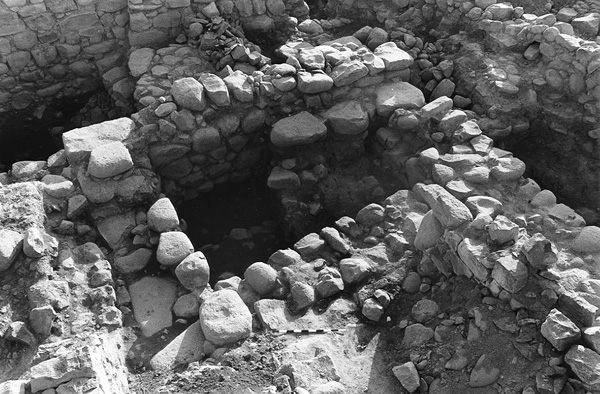
Regarding the Middle Bronze Age, the area examined where sherds of this period were retrieved was too small to identify any building remains or the exact nature of the deposit. Isolated sherds of the period were also found scattered elsewhere at the site, and objects reportedly found in a burial cave at the site and dating to a late phase of the period are on display at the Ma‘ayan Barukh museum. The Middle Bronze Age settlement appears to have been quite limited. Very few sherds of the Late Bronze Age were recovered in excavations in 1999 and 2001; the settlement of that period appears to have been extremely limited in size as well.
THE IRON AGE. In excavations conducted from 1985–1987, remains were uncovered of a tenth–ninth-century settlement, as well as of another settlement that may have dated to the seventh century BCE. In 1993, a 3.8 m stretch of a massive wall was uncovered, c. 1.5 m wide and preserved to a height of 2.2 m. A 0.6 m-thick conflagration layer containing eleventh- or tenth-century BCE sherds extended up to the base of this wall. An earth layer lacking building remains beneath this wall yielded eleventh-century BCE sherds. The corner of a courtyard enclosed with walls and paved with large stone slabs was also uncovered. In the center of the pavement was a corbelled, bell-shaped silo, which contained a small amount of sherds, mainly cooking pots with triangular rims, pithoi with collared-rims, and storage jars attributed to the eleventh century BCE.
The 1999 and 2001 seasons reached Iron Age deposits in a number of locations, wherever Hellenistic period remains were removed. Only in one spot, where a c. 50 sq-m section was excavated, was the exposure large enough to shed light on the Iron Age settlement. The remains were attributed to two strata and included buildings constructed of undressed stones and bricks. The earliest building found had been destroyed by fire, which left black ash layers and collapsed bricks, fired by the intense heat. The pottery is attributed to the Iron Age I or beginning of the Iron Age II and includes cylindrical pithoi, high-necked cooking pots, and a flask with concentric circles painted in red and black. One long wall with two openings of an Iron Age II building was exposed. One of the openings led into a room of which only the foundations of the walls remained. The building was constructed of undressed stones, many of which bore incised marks that could not be deciphered but appear to have been intentionally made. In several cases Iron Age walls were reused in buildings of the Early Hellenistic period. The Iron Age settlement apparently extended over most of the area of the site.
THE PERSIAN PERIOD. In the 1985–1987 seasons, three construction phases of the Persian period were identified: a citadel dated to the fifth century BCE and two fourth-century BCE strata. In the 1993 excavation, earthen floors with small stone installations and a tabun were revealed. These floors adjoined a massive Iron Age wall that apparently remained in use in the Persian period. Two phases were distinguished among the Persian period remains. The early phase was found only in the northern part of the site and consists of massive construction and exceptionally fine stone pavements that were apparently part of a dwelling with an attached courtyard. In the later phase, most of the area was occupied by an open courtyard carelessly paved with small stones and containing the remains of tabuns, a stone mortar, and the bones of numerous animals. In the 1999 and 2001 seasons, only isolated sherds of this period were found, including the fragment of a Persian period pinched oil lamp. These excavation results indicate that the Persian period settlement was more limited in area than its predecessor.
THE HELLENISTIC PERIOD. In the 1985–1987 seasons, two superimposed buildings were excavated in their entirety. The earlier is dated to 250–150 BCE. The later consists of a two-story building, perhaps a tower, which underwent two stages of repair and renovation (c. 150–70 BCE). These two buildings yielded numerous finds, including pottery (a substantial amount of which was imported), lamps, coins, and weapons.
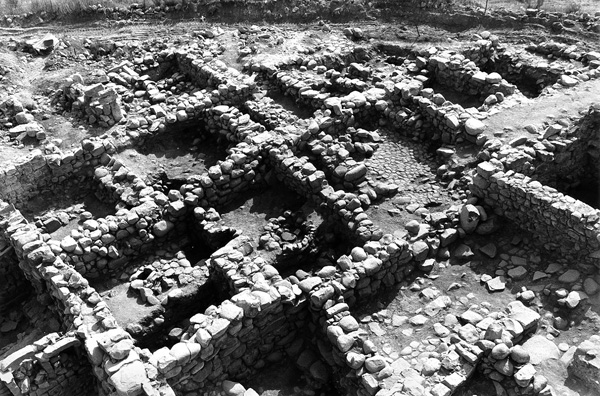
In 1993, the southern part of a building complex was excavated, partly in the center of the mound and partly in area E. The complex consists of two rows of rooms enclosing an inner courtyard. In the northeastern corner of the complex lies the massive presumed tower of the 1985–1987 excavations. In 1993, parts of surrounding rooms of similar construction were uncovered. Two building phases were identified; in the early phase some of the walls were built directly upon Persian period remains. Judging from the paucity of finds in the rooms—compared to the abundant finds in the presumed tower—these were most probably storage or service rooms that went out of use during the Hellenistic period.
During the 1999 and 2001 seasons, Hellenistic remains were encountered wherever Roman period strata were removed. Two strata of occupation and large buildings, with walls up to 2 m wide, were uncovered. Belonging to the earlier stratum is a building constructed of undressed stones. The ceramic finds of this phase are attributed to the end of the third or the beginning of the second century BCE and include a wide range of pottery of local manufacture, together with Phoenician storage jars and some vessels with a lustrous black and brown slip. Among the finds is a complete bronze lamp. Uncovered from the later stratum was a large building constructed of undressed stones with exceptionally large corner stones. Early Hellenistic period walls were often reused in the building. Two phases were distinguished. In the first phase, the foundations of undressed stones supported mud-brick walls. Two of the rooms contained three pits each; the pits were carefully lined with small undressed stones and covered with stone slabs. Three other pits used for storage were found in another room. The building was destroyed by fire, the collapsed mud-brick walls fired in the conflagration. In its second phase, the interior of the building was partitioned differently. The new walls were built above the fired mud-brick material, close to the foundations of the walls of the earlier phase. The pottery in the later phase points to a settlement in the second half of the second century and first half of the first century BCE. It consists of local and imported wares, including a significant amount of Eastern terra sigillata and numerous Phoenician storage jars.
THE ROMAN PERIOD. A settlement exposed in the 1999 and 2001 seasons was a direct continuation of the settlement of the previous period. Its remains include walls of buildings constructed of undressed basalt masonry, like that of all the buildings of the previous settlements. Most of the pottery of this settlement can be attributed to the end of the first century BCE. It includes Eastern terra sigillata and a number of cooking pots similar to the early types produced in the workshops of Kefar
In the 1999 and 2001 seasons, remains of buildings from the second and third centuries CE were uncovered in two places in the excavated area. In contrast to earlier periods, they were constructed of trimmed basalt masonry. A staircase with three steps and a threshold, which had survived to a width of 10.5 m but was apparently originally much wider, was preserved on the western slope of the mound. At the foot of the steps was an open area along the slope of the mound, its base made of undressed stones. The open area and the staircase apparently led to an outdoor bema or to the podium of a small temple destroyed during leveling works carried out in the fourth century. Drums of small columns found in secondary use in later buildings may also have belonged to this structure. The pottery associated with these structures is dated to the second and third centuries CE; isolated remains elsewhere are also dated to these centuries based on the associated pottery. Notable among these finds are disk-shaped lamps, one decorated with an erotic scene.
THE THIRD–FOURTH CENTURIES ce. Uncovered during the 1985–1987 seasons were a settlement and cemetery from the third and fourth centuries CE. Most of the graves were rich in finds, containing lamps, coins, glassware, and pottery. In 1993, an elongated building was exposed above an occupation layer of the previous period. Discovered were the presumed entrance room of the building and two stone-paved rooms, in which a series of repairs and changes in plan could be distinguished. The rooms contained fourth-century pottery. There were no signs of their deliberate destruction. Portions of courtyards equipped with tabuns and the remains of an olive-oil press with a crushing surface and screw weights were also exposed. The buildings of this stratum utilized some of the ruins of Hellenistic period buildings.
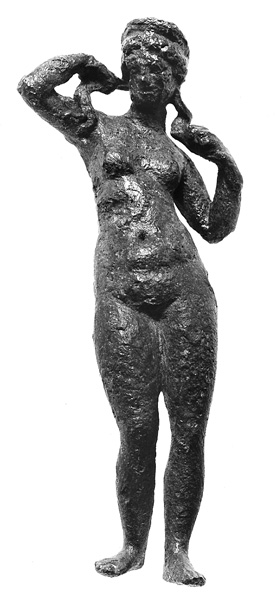
In the 1999 and 2001 seasons, more than 80 rooms of a densely built complex were uncovered over the entire excavation area. Most of the rooms were square or rectangular in shape, their floors paved with flat basalt stones. Domestic installations such as grinding stones and ovens indicate that the rooms were part of a residential complex. Five of the rooms were long and narrow, up to 15 m in length, and probably served as storerooms. At the eastern edge of the excavated area was a long enclosure wall with an opening fitted with monolithic doorjambs, probably the main entrance to the complex. Most of the buildings had floors made of flat basalt slabs. The walls were built of trimmed basalt stones; several of the interior walls were fenestrated. Central square piers supported the ceilings of some of the buildings. With the abandonment of the settlement, the ceilings and some of the walls of the houses collapsed. Hundreds of fourth-century CE coins lay in the debris. The pottery of this period is almost entirely of local manufacture. Most of the pottery resembles vessels produced in the
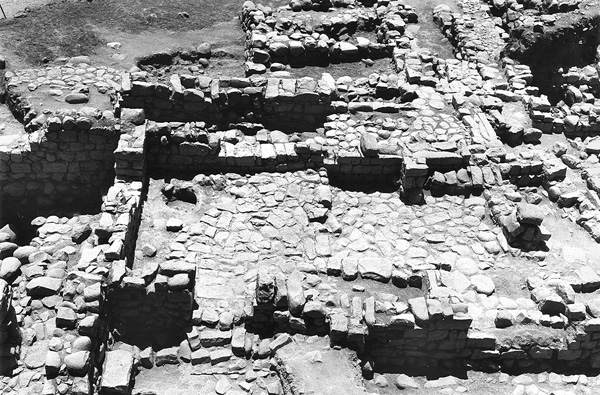
THE BYZANTINE PERIOD. During the 1985–1987 seasons, two phases of a stratum attributed to the fifth–seventh centuries CE were uncovered on the periphery of the mound. According to the evidence obtained in the 1999 and 2001 seasons, within a short time after the abandonment in the fourth century CE, the inhabitants again took up residence on the site.
Four phases of Byzantine period settlement were distinguished. In the first phase the settlers occupied a number of rooms in the buildings, while clearing the collapse debris in the other rooms. In one room, two ovens were built among the fallen stones. Extensive construction was carried out in the second phase: walls that had been partly destroyed were rebuilt, the existing buildings were newly partitioned by new walls, new stone floors were constructed above earlier ones (although in some cases the existing floors continued to be used), entrances were blocked and new entrances were opened, and most of the windows in the fenestrated interior walls were blocked. In the third phase, additional changes were made to some of the units. New walls were built and in some buildings the level of the stone floors was raised. In the fourth and final phase, all the openings and passages connecting the buildings were deliberately blocked with stone constructions. At the end of a storeroom, a solid wall with no opening was added next to two pithoi found in situ, apparently one of a number of measures indicating that the inhabitants were planning to leave the site temporarily and wished to keep their possessions safe. This final phase ended with the abandonment of the site toward the end of the sixth century.
The Byzantine pottery includes everyday vessels as well as numerous imports, mainly from Cyprus and Asia Minor, pointing to close connections with Phoenician coastal areas. Pithoi continuing the local tradition of previous periods were found. An inscription of 12 letters was incised on the neck of one of the pithoi.
THE FATIMID PERIOD. During the 1985–1987 seasons, a small stone tower (11 by 10 m) was uncovered in the middle of the mound. It was in use from the end of the early period of Muslim rule until the late Fatimid period (eleventh–mid-twelfth century). Since no other remains from this period were found, it can be assumed that the tower served as an isolated lookout post or a station on the mail route. In 1993, stone walls and stone floors were uncovered, some damaged during the construction of graves. In the 1999 and 2001 seasons, only Fatimid sherds were recovered.
THE CRUSADER PERIOD. Remains of buildings incorporating ruined structures of earlier periods were cleared in the 1985–1987 seasons. They do not form a coherent settlement plan. In the 1999 and 2001 seasons, it became evident that in the Crusader period the site continued to serve as a Fatimid station. The ruins of a small village established in the Crusader period were exposed in the northeastern part of the excavated area. Only one or two courses of the foundations of its buildings had survived; the walls were apparently built of mud bricks. The village should be identified with Nigra Gursa of Crusader sources. Among the characteristic pottery of this stratum were glazed bowls with an exterior slip extending down to the base. No pottery imported from the west or other common thirteenth-century wares were found. The finds should likely be attributed to the twelfth century.
THE MAMELUKE PERIOD. A small Mameluke settlement was excavated on the upper part of the mound in the 1985–1987 seasons. Among the remains were tabuns and storage pits; two phases were discerned. In 1993, the excavation exposed parts of shoddy stone buildings with beaten earth floors, their walls surviving to a height of one or two courses and incorporating in some cases stones of buildings from earlier strata; some pottery and coins of this period were retrieved.
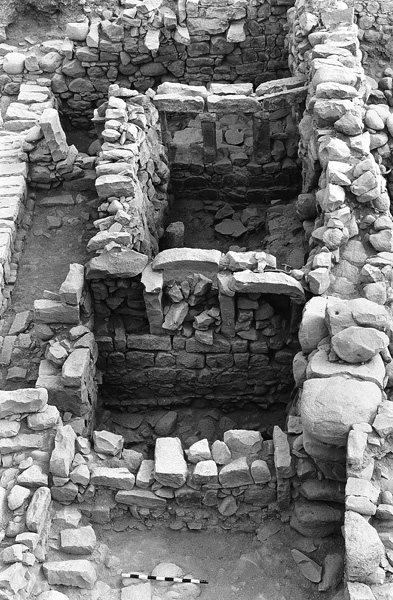
THE OTTOMAN AND BRITISH MANDATE PERIOD. A cemetery that apparently served the inhabitants of the village of Zuk
DINA AVSHALOM-GORNI, NIMROD GETZOV
EXCAVATIONS
Tel Tannim (Tell el-Wawiyat) extends over some 2 a. on a low-lying hill on the northern fringes of the
In 1993, another salvage excavation was conducted by A. Onn, R. Greenberg, I. Shaked, and Y. Rapuano on behalf of the Israel Antiquities Authority. Two areas were investigated. In area D, in the center of the mound, a trial trench was opened, extending from the Fatimid fortress (uncovered in the previous season of excavation on the summit of the mound) to the southern edge of the mound. Eleven strata of occupation, ranging from the Iron Age I to the Mameluke period, were distinguished in the trench. In area H, on the eastern slope of the mound, flint tools of the Neolithic period were uncovered, as were remains of the Early Bronze Age I–II, Iron Age I, and Byzantine period.
